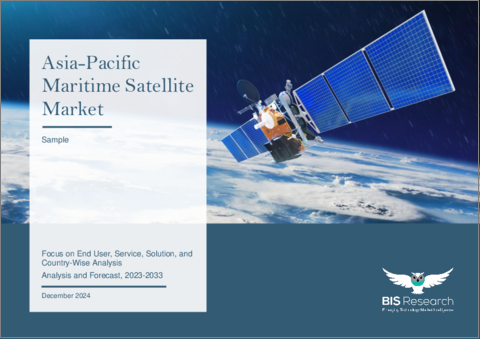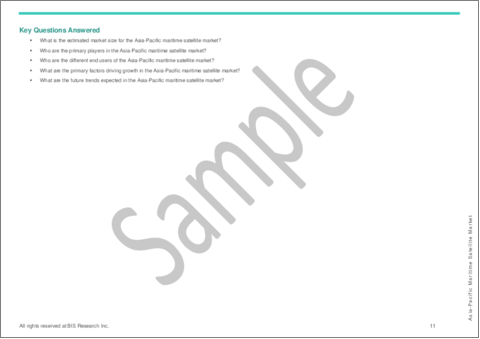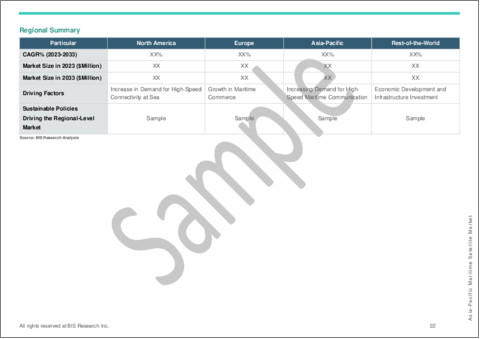|
|
市場調査レポート
商品コード
1614807
アジア太平洋の海上衛星市場:エンドユーザー・サービス・ソリューション・国別の分析・予測 (2023-2033年)Asia-Pacific Maritime Satellite Market: Focus on End User, Service, Solution, and Country-Wise Analysis - Analysis and Forecast, 2023-2033 |
||||||
カスタマイズ可能
|
|||||||
| アジア太平洋の海上衛星市場:エンドユーザー・サービス・ソリューション・国別の分析・予測 (2023-2033年) |
|
出版日: 2024年12月17日
発行: BIS Research
ページ情報: 英文 58 Pages
納期: 1~5営業日
|
全表示
- 概要
- 図表
- 目次
アジア太平洋地域の海上衛星の市場規模は、2023年の13億8,610万米ドルから、予測期間中は10.19%のCAGRで推移し、2033年には36億5,650万米ドルの規模に達すると予測されています。
アジア太平洋地域の海洋部門において、海上衛星は運航の効率性、安全性、規制遵守の向上に不可欠です。孤立した海域で信頼できる接続性を提供することで、船舶監視、救助任務、円滑な国際貿易などの重要な業務を促進しています。これらの衛星は、通信インフラを強化し、技術統合を拡大し、物流を改善することで、海洋産業のデジタルトランスフォーメーションを促進する上で重要な役割を果たしています。
| 主要市場統計 | |
|---|---|
| 予測期間 | 2023-2033年 |
| 2023年評価 | 13億8,610万米ドル |
| 2033年予測 | 36億5,650万米ドル |
| CAGR | 10.19% |
アジアの海洋部門は世界貿易と海運の中心地として機能しており、海上衛星は経済成長、地域の連結性、よりスマートで相互接続された海洋エコシステムの発展を確実なものにするために不可欠なものとなっています。
同地域で急成長しているオフショアエネルギー事業、海上貿易、広大な海洋での継続的な通信の必要性はすべて、同地域の海上衛星市場の急速な拡大を推進しています。海上衛星は、遠隔地や外洋で活動する商業貨物船、漁船、クルーズライナー、プライベートヨット、海軍フリートに、高速インターネット、音声・データ転送、ナビゲーション、安全ソリューションなどの重要な通信サービスを提供します。
アジア太平洋地域は海上貿易に強く依存しており、世界の海運のかなりの部分を占めているため、信頼性の高い通信システムは、業務の有効性と安全性の両方にとって極めて重要です。特に、中国、日本、韓国、東南アジアなど、国際海運やオフショアに大きく関与している国々では、海上衛星技術が船舶の監視を改善し、物流を合理化し、規制遵守を保証しています。
同市場は、VSATシステム、IoT対応モニタリング、高スループット衛星 (HTS) の使用など、衛星技術の進歩の結果として成長しています。これらの技術は、帯域幅の改善、費用対効果、信頼性の高い接続性を提供することで、海洋産業全体のデジタル化を可能にします。アジア太平洋地域の海上衛星通信ソリューションの採用は、乗組員の福利厚生、安全性、持続可能な運航の重視の高まりによっても加速しています。
市場セグメンテーション
セグメント1:エンドユーザー別
- 商船
- 漁業
- 旅客船
- オフショア
- 政府
- その他
セグメント2:サービス別
- トラッキング&モニタリング
- 音声
- ビデオ
- データ
セグメント3:ソリューション別
- 超小型開口ターミナル (VSAT)
- 移動体衛星サービス (MSS)
セグメント4:地域別
- 中国、インド、日本、その他
当レポートでは、アジア太平洋の海上衛星の市場を調査し、業界の動向、技術・特許の動向、法規制環境、市場成長促進要因・抑制要因、市場規模の推移・予測、各種区分・主要国別の詳細分析、競合情勢、主要企業のプロファイルなどをまとめています。
目次
エグゼクティブサマリー
範囲と定義
第1章 市場
- 動向:現在および将来の影響評価
- 高スループット衛星 (HTS) の台頭
- 海上通信におけるIoTの統合
- フラットパネルアンテナへの移行
- サプライチェーンの概要
- バリューチェーン分析
- 規制と環境に関する考慮事項
- 今後の小型衛星通信コンステレーション:海上衛星市場の成長要因
- エコシステム/進行中のプログラム
- インドネシアの衛星コンステレーション
- 業界ユースケース
- Maersk Supply Service
- KVH Industries, Inc.
- スタートアップの資金調達の概要
- 市場力学の概要
- 事業推進因子
- 事業上の課題
- 事業機械
第2章 地域
- 地域別概要
- 成長推進因子・抑制因子
- アジア太平洋
- 地域概要
- 市場成長の原動力
- 市場課題
- 中国
- インド
- 日本
- その他
- 用途
- 製品
第3章 市場:競合ベンチマーキングと企業プロファイル
- 次なるフロンティア
- 地理的評価
第4章 調査手法
List of Figures
- Figure 1: Region with the Largest Share of Market, 2022, 2026, and 2033
- Figure 2: Asia-Pacific Maritime Satellite Market (by End User), 2022, 2026, and 2033
- Figure 3: Asia-Pacific Maritime Satellite Market (by Service), 2022, 2026, and 2033
- Figure 4: Asia-Pacific Maritime Satellite Market (by Solution), 2022, 2026, and 2033
- Figure 5: Maritime Satellite, Recent Developments
- Figure 6: Impact Analysis of Market Navigating Factors, 2023-2033
- Figure 7: China Maritime Satellite Market, $Million, 2022-2033
- Figure 8: India Maritime Satellite Market, $Million, 2022-2033
- Figure 9: Japan Maritime Satellite Market, $Million, 2022-2033
- Figure 10: Rest-of-Asia-Pacific Maritime Satellite Market, $Million, 2022-2033
- Figure 11: Strategic Initiatives, 2020-2024
- Figure 12: Share of Strategic Initiatives
- Figure 13: Data Triangulation
- Figure 14: Top-Down and Bottom-Up Approach
- Figure 15: Assumptions and Limitations
List of Tables
- Table 1: Market Snapshot
- Table 2: Maritime Satellite Market, Opportunities across Regions
- Table 3: Maritime Satellite Market (by Region), $Million, 2022-2033
- Table 4: Asia-Pacific Maritime Satellite Market (by Service), $Million, 2022-2033
- Table 5: Asia-Pacific Maritime Satellite Market (by End User), $Million, 2022-2033
- Table 6: Asia-Pacific Maritime Satellite Market (by Service), $Million, 2022-2033
- Table 7: Asia-Pacific Maritime Satellite Market (by Solution), $Million, 2022-2033
- Table 8: China Maritime Satellite Market (by End User), $Million, 2022-2033
- Table 9: China Maritime Satellite Market (by Service), $Million, 2022-2033
- Table 10: China Maritime Satellite Market (by Solution), $Million, 2022-2033
- Table 11: India Maritime Satellite Market (by End User), $Million, 2022-2033
- Table 12: India Maritime Satellite Market (by Service), $Million, 2022-2033
- Table 13: India Maritime Satellite Market (by Solution), $Million, 2022-2033
- Table 14: Japan Maritime Satellite Market (by End User), $Million, 2022-2033
- Table 15: Japan Maritime Satellite Market (by Service), $Million, 2022-2033
- Table 16: Japan Maritime Satellite Market (by Solution), $Million, 2022-2033
- Table 17: Rest-of-Asia-Pacific Maritime Satellite Market (by End User), $Million, 2022-2033
- Table 18: Rest-of-Asia-Pacific Maritime Satellite Market (by Service), $Million, 2022-2033
- Table 19: Rest-of-Asia-Pacific Maritime Satellite Market (by Solution), $Million, 2022-2033
Introduction to Asia-Pacific Maritime Satellite Market
The Asia-Pacific maritime satellite market is estimated to reach $3,656.5 million by 2033 from $1,386.1 million in 2023, growing at a CAGR of 10.19% during the forecast period 2023-2033. Maritime satellites, a specialist satellite communication industry, are made to satisfy the particular requirements of maritime operations throughout the vast oceans and seas of Asia-Pacific. These satellites give commercial cargo ships, cruise liners, private yachts, and naval forces vital services like high-speed internet, voice and data transfer, navigation, and safety solutions.
Throughout the APAC maritime sector, maritime satellites are essential for improving operational effectiveness, safety, and regulatory compliance. They facilitate vital operations like ship surveillance, rescue missions, and smooth international trade by providing dependable connectivity in isolated maritime areas. These satellites play a crucial role in facilitating the digital transformation of the maritime industry by enhancing communication infrastructure, expanding technology integration, and improving logistics.
| KEY MARKET STATISTICS | |
|---|---|
| Forecast Period | 2023 - 2033 |
| 2023 Evaluation | $1,386.1 Million |
| 2033 Forecast | $3,656.5 Million |
| CAGR | 10.19% |
With the marine sector in Asia acting as a center for global trade and shipping, maritime satellites are essential to ensuring economic growth, regional connectivity, and the development of a smarter, more interconnected maritime ecosystem.
Market Introduction
The region's burgeoning offshore energy operations, maritime trade, and need for continuous communication across huge oceans are all driving the APAC maritime satellite market's rapid expansion. For commercial cargo ships, fishing vessels, cruise liners, private yachts, and naval fleets operating in remote and open-sea areas, maritime satellites offer vital communication services like high-speed internet, voice and data transfer, navigation, and safety solutions.
Due to the region's strong reliance on marine trade-which accounts for a sizeable portion of worldwide shipping-reliable communication systems are crucial for both operational effectiveness and safety. Particularly in nations like China, Japan, South Korea, and Southeast Asia, which are significant participants in international shipping and offshore, maritime satellite technology improves vessel surveillance, streamlines logistics, and guarantees regulatory compliance.
The market is growing as a result of advancements in satellite technology, such as the use of VSAT systems, IoT-enabled monitoring, and high-throughput satellites (HTS). These technologies enable digitization throughout the maritime industry by providing improved bandwidth, cost effectiveness, and reliable connectivity. APAC's adoption of maritime satellite communication solutions is also being accelerated by the growing emphasis on crew welfare, safety, and sustainable operations.
The APAC maritime satellite market will continue to play a crucial role in promoting trade, enhancing safety, and cultivating the region's technologically sophisticated and integrated maritime ecosystem as maritime operations expand.
Market Segmentation:
Segmentation 1: by End User
- Merchant Shipping
- Fishing
- Passenger Ship
- Offshore
- Government
- Others
Segmentation 2: by Service
- Tracking and Monitoring
- Voice
- Video
- Data
Segmentation 3: by Solution
- Very Small Aperture Terminal (VSAT)
- Mobile Satellite Service (MSS)
Segmentation 4: by Region
- Asia-Pacific - China, India, Japan, and Rest-of-Asia-Pacific
How can this report add value to an organization?
Product/Innovation Strategy: The product segment helps the reader understand the different types of solutions available for deployment and their potential in APAC region. Moreover, the study provides the reader with a detailed understanding of the maritime satellite market (by application) on the basis of the end user (merchant shipping, fishing, passenger ship, offshore, government, and others) and on the basis of service (tracking and monitoring, voice, video, and data), and product on the basis of solution (very small aperture terminal (VSAT), and mobile satellite service (MSS)).
Growth/Marketing Strategy: The APAC maritime satellite market has seen major development by key players operating in the market, such as business expansion, partnership, collaboration, and joint venture. The favored strategy for the companies has been partnerships and contracts to strengthen their position in the maritime satellite market.
Table of Contents
Executive Summary
Scope and Definition
1 Markets
- 1.1 Trends: Current and Future Impact Assessment
- 1.1.1 Rise of High-Throughput Satellite (HTS)
- 1.1.2 Integration of the Internet of Things (IoT) in Maritime Communication
- 1.1.3 Migration to Flat-Panel Antennas
- 1.2 Supply Chain Overview
- 1.2.1 Value Chain Analysis
- 1.3 Regulatory and Environmental Considerations
- 1.3.1 Regulatory Implications
- 1.4 Upcoming Small Satellite Communication Constellation: A Growth Factor in Maritime Satellite Market
- 1.5 Ecosystem/Ongoing Programs
- 1.5.1 Indonesia's Satellite Constellation
- 1.6 Industry Use Cases
- 1.6.1 Maersk Supply Service Selects Inmarsat Fleet Data End User API to Optimize the Performance of Battery-Powered Vessel
- 1.6.2 KVH Industries, Inc.'s AgilePlans One Allows Ocean Minerals LLC to Bring TracNet H90's Hybrid Connectivity Onboard
- 1.7 Startup Funding Summary
- 1.8 Market Dynamics Overview
- 1.8.1 Business Drivers
- 1.8.1.1 Enhanced Maritime Communication Needs
- 1.8.1.2 Globalization of Trade and Increasing Sea Traffic
- 1.8.1.3 Advancements in Satellite Technology
- 1.8.2 Business Challenges
- 1.8.2.1 Increasing Concerns about Cybersecurity Threats
- 1.8.2.2 Competition from Alternative Technologies
- 1.8.2.3 High Investment and Operating Cost
- 1.8.3 Business Opportunities
- 1.8.3.1 Integration with IoT and Big Data Analytics
- 1.8.3.2 Hybrid Satellite Networks
- 1.8.1 Business Drivers
2 Regions
- 2.1 Regional Summary
- 2.2 Drivers and Restraints
- 2.3 Asia-Pacific
- 2.3.1 Regional Overview
- 2.3.2 Driving Factors for Market Growth
- 2.3.3 Factors Challenging the Market
- 2.3.4 Application
- 2.3.5 Product
- 2.3.6 China
- 2.3.7 Application
- 2.3.8 Product
- 2.3.9 India
- 2.3.10 Application
- 2.3.11 Product
- 2.3.12 Japan
- 2.3.13 Application
- 2.3.14 Product
- 2.3.15 Rest-of-Asia-Pacific
- 2.3.16 Application
- 2.3.17 Product
3 Markets - Competitive Benchmarking & Company Profiles
- 3.1 Next Frontiers
- 3.2 Geographic Assessment
4 Research Methodology
- 4.1 Data Sources
- 4.1.1 Primary Data Sources
- 4.1.2 Secondary Data Sources
- 4.1.3 Data Triangulation
- 4.2 Market Estimation and Forecast





